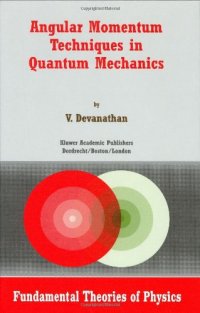
Ebook: Angular Momentum Techniques in Quantum Mechanics
Author: V. Devanathan (auth.)
- Genre: Mathematics // Mathematicsematical Physics
- Tags: Mathematical and Computational Physics, Quantum Physics, Nuclear Physics Heavy Ions Hadrons, Atoms Molecules Clusters and Plasmas
- Series: Fundamental Theories of Physics 108
- Year: 2002
- Publisher: Springer Netherlands
- Edition: 1
- Language: English
- pdf
A course in angular momentum techniques is essential for quantitative study of problems in atomic physics, molecular physics, nuclear physics and solid state physics. This book has grown out of such a course given to the students of the M. Sc. and M. Phil. degree courses at the University of Madras. An elementary knowledge of quantum mechanics is an essential pre-requisite to undertake this course but no knowledge of group theory is assumed on the part of the readers. Although the subject matter has group-theoretic origin, special efforts have been made to avoid the gro- theoretical language but place emphasis on the algebraic formalism dev- oped by Racah (1942a, 1942b, 1943, 1951). How far I am successful in this project is left to the discerning reader to judge. After the publication of the two classic books, one by Rose and the other by Edmonds on this subject in the year 1957, the application of angular momentum techniques to solve physical problems has become so common that it is found desirable to organize a separate course on this subject to the students of physics. It is to cater to the needs of such students and research workers that this book is written. A large number of questions and problems given at the end of each chapter will enable the reader to have a clearer understanding of the subject.
This book deals with the coupling of two or more angular momenta, angular momentum coupling coefficients, rotation matrices, tensor operators, evaluation of matrix elements, the gradient formula, identical particles, statistical tensors and polarization phenomena, traces of angular momentum matrices, the helicity formalism and the spin states of the Dirac particle. These topics cover the entire range of angular momentum techniques that are being widely used in the study of both non-relativistic and relativistic problems in physics. At the end of each chapter, review questions, problems and solutions to selected problems are given in order to enable the reader to have a clearer understanding of the subject. Audience: This volume will serve as a valuable reference monograph for research workers in particle physics, nuclear physics and material science. It is also recommended as a text in angular momentum techniques for graduate students of physics and chemistry.